Abstract
We examined methods for determining how extinction should be applied to different functions of self-injurious behavior (SIB). Assessment data indicated that the head banging of 3 children with developmental disabilities was maintained by different reinforcement contingencies: One subject's SIB was positively reinforced by attention from adults, the 2nd subjects SIB was negatively reinforced by escape from educational tasks, and the 3rd subject's SIB appeared to be automatically reinforced or "self-stimulatory" in nature. Three functional variations of extinction--EXT (attention), EXT (escape), and EXT (sensory)--were evaluated, and each subject was exposed to at least two of these variations in reversal or multiple baseline designs. Reductions in SIB were observed only when implementation of "extinction" involved the discontinuation of reinforcement previously shown to be responsible for maintaining the behavior. These results highlight important differences among treatment techniques based on the same behavioral principle (extinction) when applied to topographically similar but functionally dissimilar responses, and further illustrate the practical implications of a functional analysis of behavior disorders for designing, selecting, and classifying therapeutic interventions.
Full text
PDF
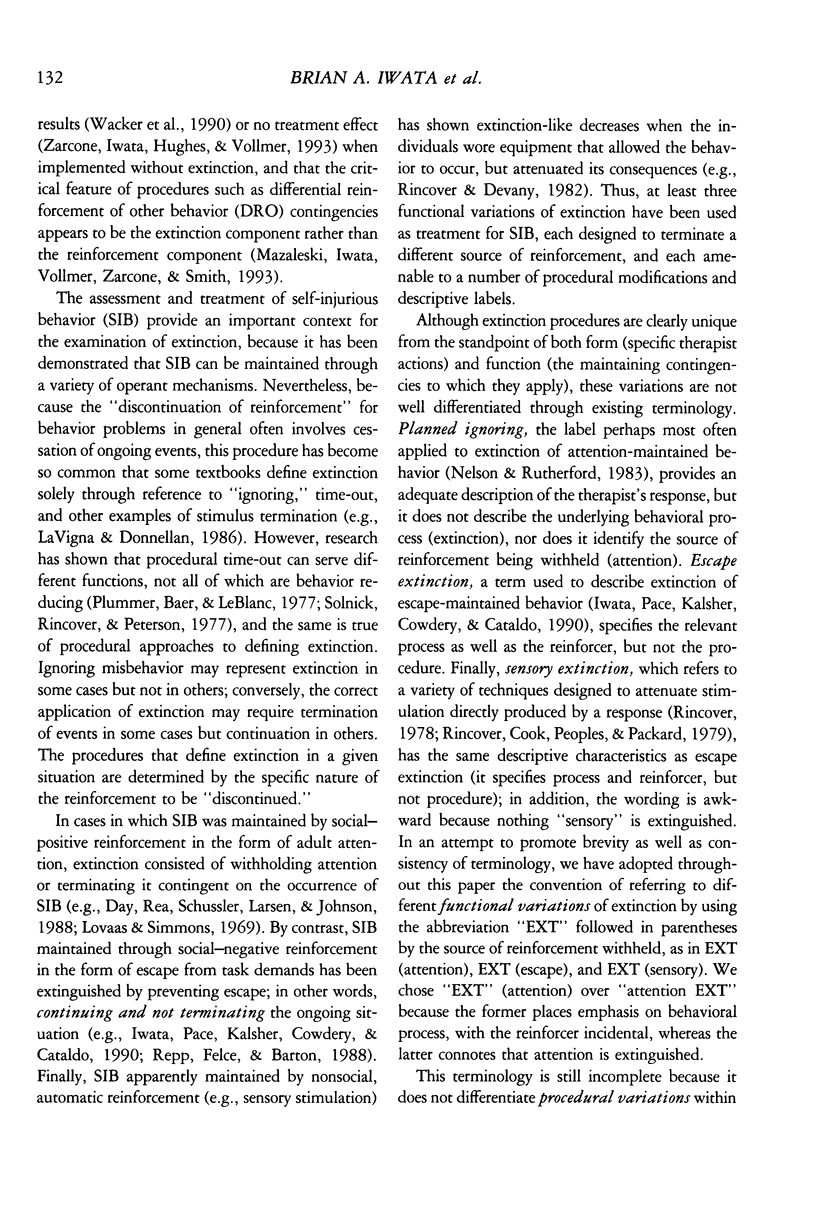


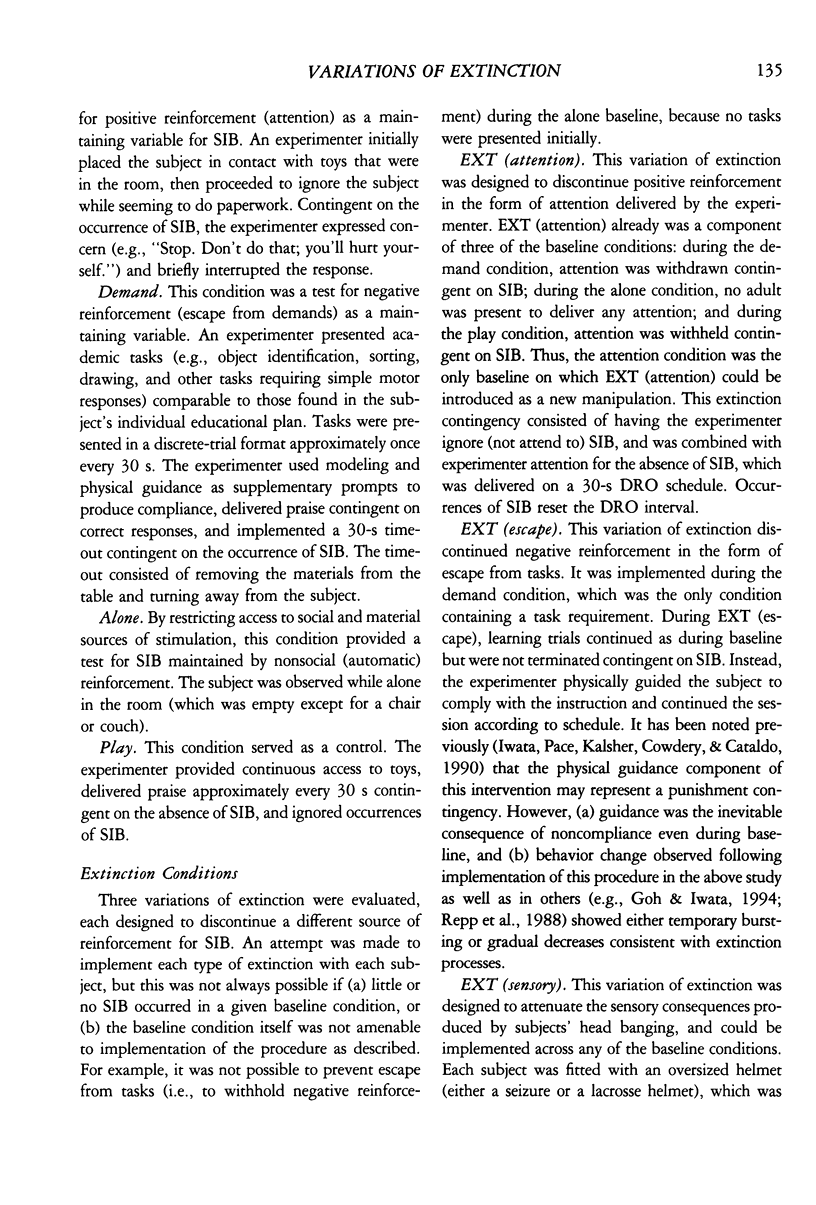
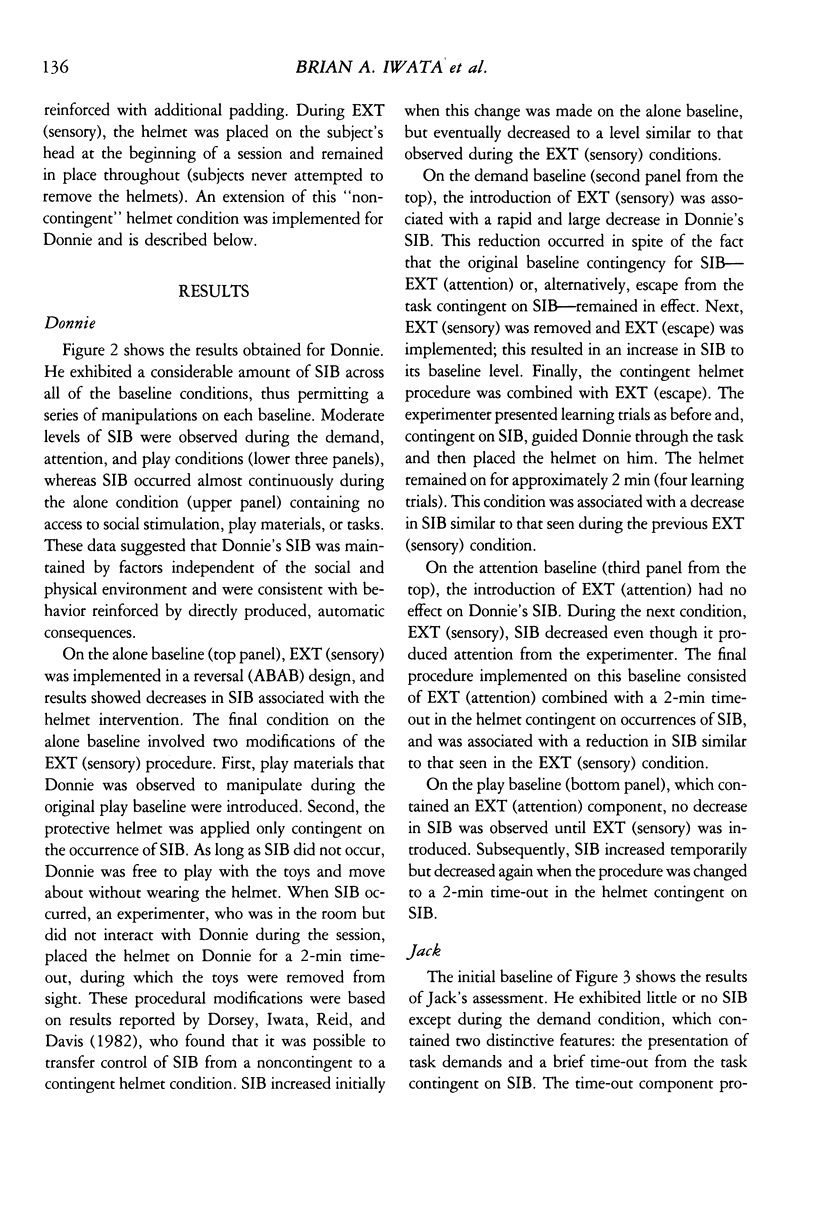
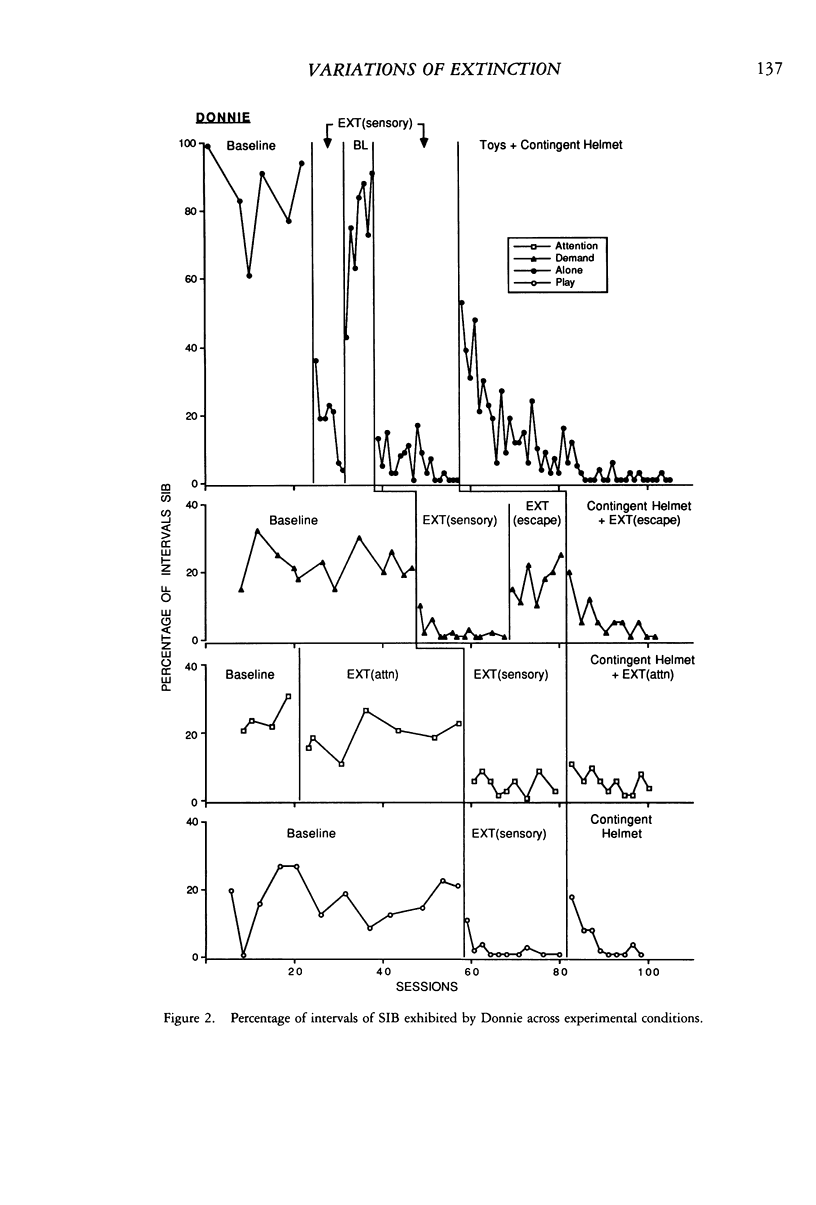
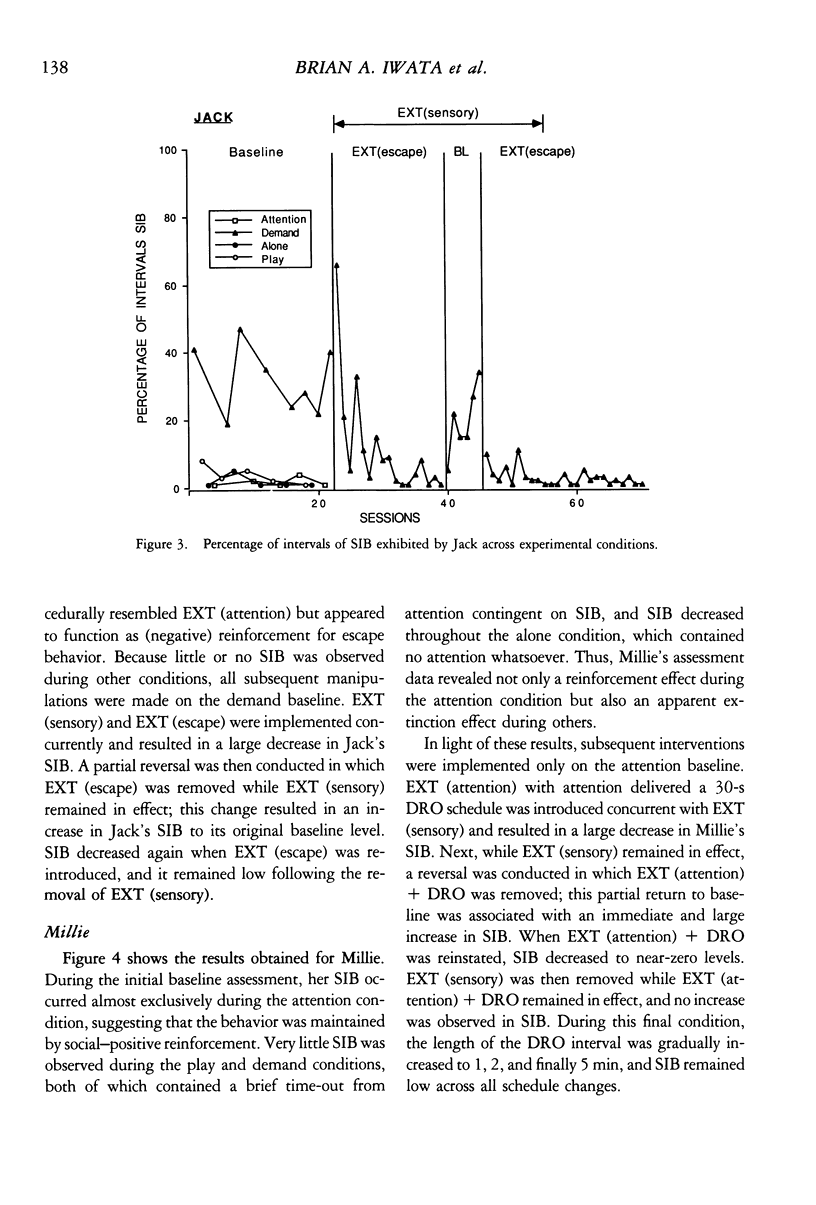




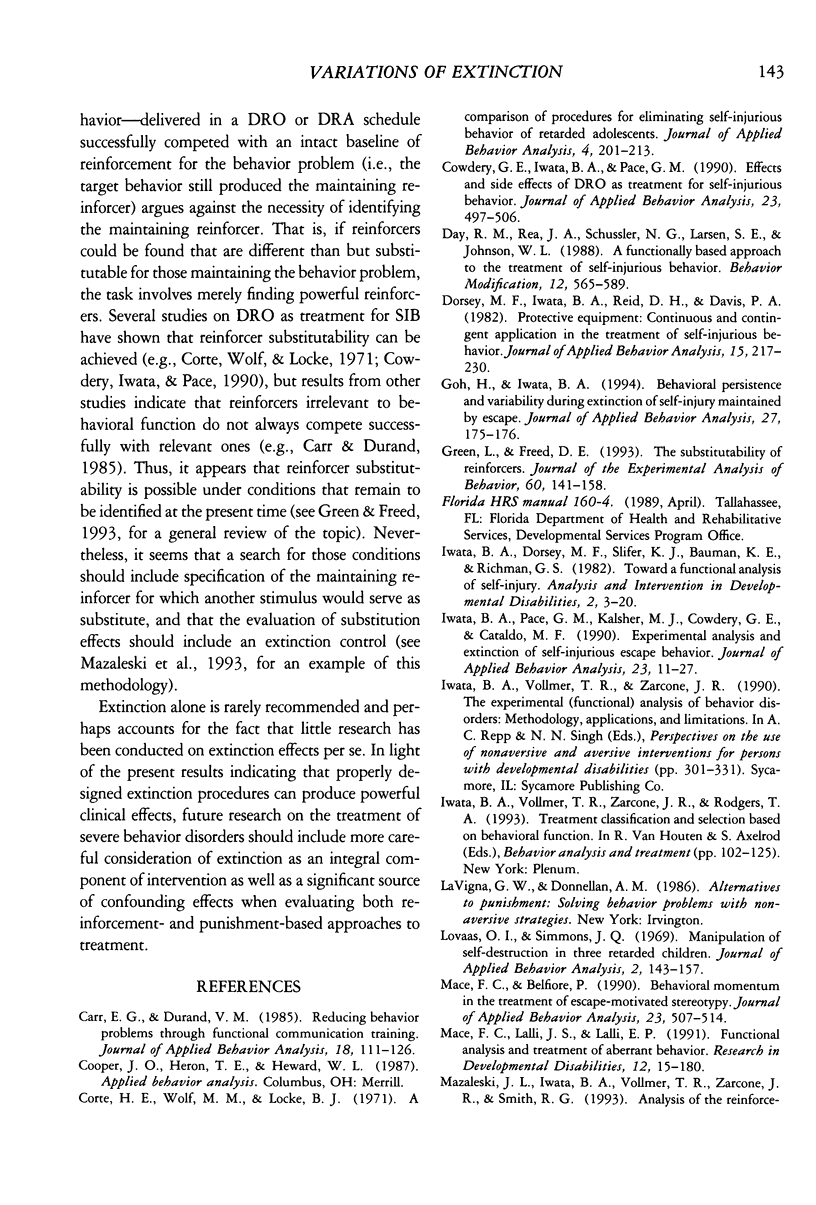

Images in this article
Selected References
These references are in PubMed. This may not be the complete list of references from this article.
- Bakke B. L., Kvale S., Burns T., McCarten J. R., Wilson L., Maddox M., Cleary J. Multicomponent intervention for agitated behavior in a person with Alzheimer's disease. J Appl Behav Anal. 1994 Spring;27(1):175–176. doi: 10.1901/jaba.1994.27-175. [DOI] [PMC free article] [PubMed] [Google Scholar]
- Carr E. G., Durand V. M. Reducing behavior problems through functional communication training. J Appl Behav Anal. 1985 Summer;18(2):111–126. doi: 10.1901/jaba.1985.18-111. [DOI] [PMC free article] [PubMed] [Google Scholar]
- Corte H. E., Wolf M. M., Locke B. J. A comparison of procedures for eliminating self-injurious behavior of retarded adolescents. J Appl Behav Anal. 1971 Fall;4(3):201–213. doi: 10.1901/jaba.1971.4-201. [DOI] [PMC free article] [PubMed] [Google Scholar]
- Cowdery G. E., Iwata B. A., Pace G. M. Effects and side effects of DRO as treatment for self-injurious behavior. J Appl Behav Anal. 1990 Winter;23(4):497–506. doi: 10.1901/jaba.1990.23-497. [DOI] [PMC free article] [PubMed] [Google Scholar]
- Day R. M., Rea J. A., Schussler N. G., Larsen S. E., Johnson W. L. A functionally based approach to the treatment of self-injurious behavior. Behav Modif. 1988 Oct;12(4):565–589. doi: 10.1177/01454455880124005. [DOI] [PubMed] [Google Scholar]
- Dorsey M. F., Iwata B. A., Reid D. H., Davis P. A. Protective equipment: continuous and contingent application in the treatment of self-injurious behavior. J Appl Behav Anal. 1982 Summer;15(2):217–230. doi: 10.1901/jaba.1982.15-217. [DOI] [PMC free article] [PubMed] [Google Scholar]
- Green Leonard, Freed Debra E. The substitutability of reinforcers. J Exp Anal Behav. 1993 Jul;60(1):141–158. doi: 10.1901/jeab.1993.60-141. [DOI] [PMC free article] [PubMed] [Google Scholar]
- Iwata B. A., Pace G. M., Kalsher M. J., Cowdery G. E., Cataldo M. F. Experimental analysis and extinction of self-injurious escape behavior. J Appl Behav Anal. 1990 Spring;23(1):11–27. doi: 10.1901/jaba.1990.23-11. [DOI] [PMC free article] [PubMed] [Google Scholar]
- Lovaas O. I., Simmons J. Q. Manipulation of self-destruction in three retarded children. J Appl Behav Anal. 1969 Fall;2(3):143–157. doi: 10.1901/jaba.1969.2-143. [DOI] [PMC free article] [PubMed] [Google Scholar]
- Mace F. C., Belfiore P. Behavioral momentum in the treatment of escape-motivated stereotypy. J Appl Behav Anal. 1990 Winter;23(4):507–514. doi: 10.1901/jaba.1990.23-507. [DOI] [PMC free article] [PubMed] [Google Scholar]
- Mace F. C., Lalli J. S., Lalli E. P. Functional analysis and treatment of aberrant behavior. Res Dev Disabil. 1991;12(2):155–180. doi: 10.1016/0891-4222(91)90004-c. [DOI] [PubMed] [Google Scholar]
- Mazaleski J. L., Iwata B. A., Vollmer T. R., Zarcone J. R., Smith R. G. Analysis of the reinforcement and extinction components in DRO contingencies with self-injury. J Appl Behav Anal. 1993 Summer;26(2):143–156. doi: 10.1901/jaba.1993.26-143. [DOI] [PMC free article] [PubMed] [Google Scholar]
- Plummer S., Baer D. M., LeBlanc J. M. Functional considerations in the use of procedural timeout and in effective alternative. J Appl Behav Anal. 1977 Winter;10(4):689–705. doi: 10.1901/jaba.1977.10-689. [DOI] [PMC free article] [PubMed] [Google Scholar]
- Repp A. C., Felce D., Barton L. E. Basing the treatment of stereotypic and self-injurious behaviors on hypotheses of their causes. J Appl Behav Anal. 1988 Fall;21(3):281–289. doi: 10.1901/jaba.1988.21-281. [DOI] [PMC free article] [PubMed] [Google Scholar]
- Rincover A., Cook R., Peoples A., Packard D. Sensory extinction and sensory reinforcement principles for programming multiple adaptive behavior change. J Appl Behav Anal. 1979 Summer;12(2):221–233. doi: 10.1901/jaba.1979.12-221. [DOI] [PMC free article] [PubMed] [Google Scholar]
- Rincover A. Sensory extinction: a procedure form eliminating self-stimulatory behavior in developmentally disabled children. J Abnorm Child Psychol. 1978 Sep;6(3):299–310. doi: 10.1007/BF00924733. [DOI] [PubMed] [Google Scholar]
- Solnick J. V., Rincover A., Peterson C. R. Some determinants of the reinforcing and punishing effects of timeout. J Appl Behav Anal. 1977 Fall;10(3):415–424. doi: 10.1901/jaba.1977.10-415. [DOI] [PMC free article] [PubMed] [Google Scholar]
- Steege M. W., Wacker D. P., Cigrand K. C., Berg W. K., Novak C. G., Reimers T. M., Sasso G. M., DeRaad A. Use of negative reinforcement in the treatment of self-injurious behavior. J Appl Behav Anal. 1990 Winter;23(4):459–467. doi: 10.1901/jaba.1990.23-459. [DOI] [PMC free article] [PubMed] [Google Scholar]
- Wacker D. P., Steege M. W., Northup J., Sasso G., Berg W., Reimers T., Cooper L., Cigrand K., Donn L. A component analysis of functional communication training across three topographies of severe behavior problems. J Appl Behav Anal. 1990 Winter;23(4):417–429. doi: 10.1901/jaba.1990.23-417. [DOI] [PMC free article] [PubMed] [Google Scholar]
- Zarcone J. R., Iwata B. A., Hughes C. E., Vollmer T. R. Momentum versus extinction effects in the treatment of self-injurious escape behavior. J Appl Behav Anal. 1993 Spring;26(1):135–136. doi: 10.1901/jaba.1993.26-135. [DOI] [PMC free article] [PubMed] [Google Scholar]



